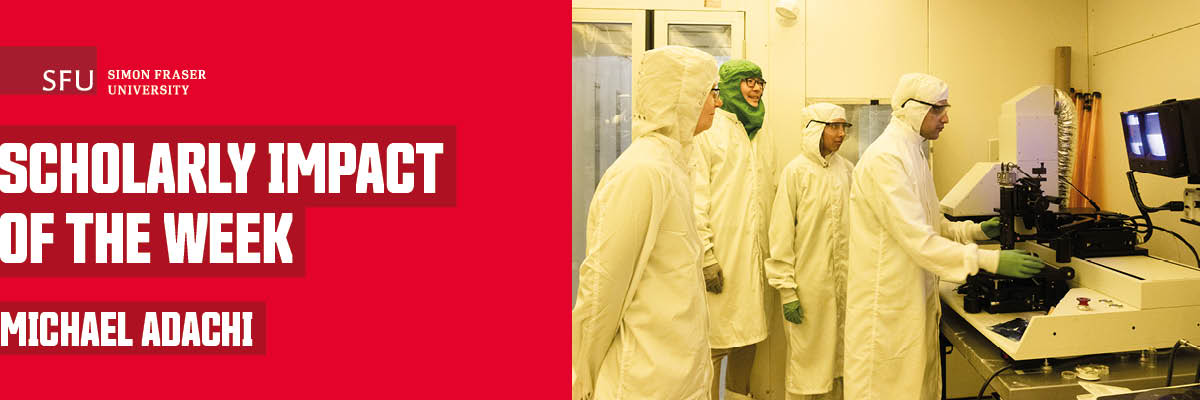
What if we could test for and treat a disease before noticing symptoms? Researchers at Simon Fraser University (SFU) are working on ultrasensitive, rapid sensors that can signal disease at an early stage using cytokine biomarkers. Biomarkers are measurable molecular indicators in the body commonly used to detect cancers, determine the severity of heart attacks and avoid invasive diagnostics.
Engineering science professor Michael Adachi leads the Nanodevice Fabrication Group at SFU, which designs and fabricates new devices for diagnostic sensors and photodetectors using nanotechnology. As a nanoengineer, Adachi uses his expertise with advanced materials such as two-dimensional materials, quantum dots, thin film semiconductors, and nanowires to design technologies with enhanced properties.
He and his lab have recently been working on developing a tool to rapidly detect multiple biomarker proteins that signal inflammation in the body that could be indicators of Alzheimer’s disease, COVID-19 and other diseases. The multidisciplinary project was led by investigators Adachi, physics professor Karen Kavanagh and biomedical physiology and kinesiology professor Miriam Rosin, and graduate students Thushani De Silva and Mirette Fawzy.
The result of the collaboration is a diode sensor that is user-friendly, simple to build and has the potential to be applied in a rapid and easy-to-use point-of-care diagnostic tool. The new sensors are small enough to be placed in doctor’s offices to help diagnose different diseases, including Alzheimer’s. And, they are sensitive enough to potentially detect disease at an early stage, when treatment is most effective, and when people can get an early start in the lifestyle changes that promote brain and cardiovascular health.
Adachi’s article describing the collaboration, Ultrasensitive rapid cytokine sensors based on asymmetric geometry two-dimensional MoS2 diodes, was recently published in Nature Communications.
We spoke with professor Adachi about his work.
Can you tell us how the sensor works from a biomedical perspective? How would it work from a clinician’s perspective?
Our sensors use nanosheets to detect very small interactions that occur at its surface. Receptor molecules—called aptamers—attached to the sensor surface bind specifically to an inflammatory biomarker called Tumor Necrosis Factor alpha (TNF-alpha). When a solution containing TNF-alpha is placed on the sensor, the interaction with the sensor surface results in a change in the electrical output, which can tell us how much of the biomarker is present in the solution.
From a clinical perspective, the sensors can provide information about biomarker levels in blood samples which has potential to help doctors diagnose a disease or help determine if a person may be at risk of developing a disease.
Can the sensor be modified to identify the biomarkers of other diseases?
In principle, yes. The sensor uses receptor molecules that bind specifically to TNF-alpha. In theory, the TNF-alpha binding aptamer could be swapped out with different aptamer or another receptor molecule such as an antibody to detect a different biomarker molecule. We are currently in the process of modifying the sensor to detect a biomarker protein more specific to Alzheimer’s.
What are the next steps in moving this technology from the lab to a doctor’s office?
So far, our sensors have been tested in a well-controlled environment using biomarker proteins diluted in a buffer solution. One of the next steps is to improve the sensor’s ability to detect a biomarker protein when it’s surrounded by other interfering substances found in blood such as other proteins, lipids or other substances. Other steps include modifying the fabrication process to make a repeatable measurement that can be scaled for production.
How important is multidisciplinary collaboration to a project like this?
Health-related devices use expertise in a variety of areas including physics, electrical engineering, chemistry, molecular biology, kinesiology, etc. Therefore, having multidisciplinary collaborations and a research team consisting of students trained with different backgrounds lead to new questions and viewpoints which may help find solutions to a complex research problem.
What do you enjoy most about your work as a nanoscientist?
Nanomaterials exhibit unique material properties not found in traditional bulk materials and researchers are discovering new properties in nanomaterials all the time. I enjoy working with students and collaborators to investigate how some of these material properties could be used in new practical device applications.
For more: SFU scientists developing early Alzheimer’s disease detection sensor
SFU's Scholarly Impact of the Week series does not reflect the opinions or viewpoints of the university, but those of the scholars. The timing of articles in the series is chosen weeks or months in advance, based on a published set of criteria. Any correspondence with university or world events at the time of publication is purely coincidental.
For more information, please see SFU's Code of Faculty Ethics and Responsibilities and the statement on academic freedom.